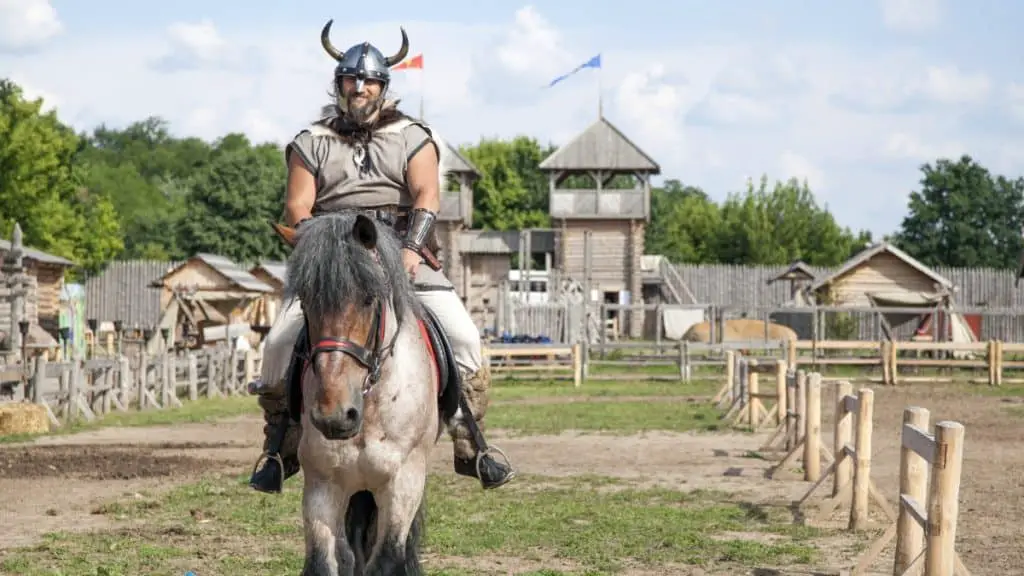Skip To Section
Did Vikings ride horses? Unlike other warrior tribes, horses were not a fixture for Vikings. More often, they were used on the farm, or as pack animals. The ability to travel long distances in rugged terrain and harsh weather required special types of horses. The Icelandic Pony was one, so were the Norwegian Fjord ponies, the Danish Jutland horses and the Shetland ponies.

Characteristics Coveted By Vikings In Horses
The Vikings flourished in Europe for close to three hundred years – the Viking Age is officially designated as the period between 793 to 1066 AD. They were explorers who went routinely into undiscovered territories, raiding, colonizing, sometimes settling and always trading.
While their travels ranged throughout Europe – including the British Isles – and as far as North America, the toughest terrain conquered by the Vikings was likely their own backyard. The Norsemen explored and settled foreboding areas in Norway, Denmark and Sweden. The era of exploration and settlement peaked between the 9th to the 11th century AD.
The Viking thirst to explore likely arose from a population explosion in the late 8th century, which led to a lack of farmland. Coupled with what they considered easy pickings (that is, no unified opposition), led to their explorations in the British Isles, Iceland and other places. However, conquest was always tempered with the need for more settlements to support their ways of life.
In their quests and homes, Vikings preferred certain types of horses.
Pack And Farm Horses
The breeds of horses that were the ideal companions on these journeys would need to be tireless workers, sturdy, able to work in harsh weather conditions, travel over rough terrains and survive on limited quantities of food and rest – compact horses with good balance. As such, they differed from the fine-looking but more finicky horse breeds found in southern Europe, the Middle East and elsewhere.
War Horses
As mentioned above, the Vikings probably did not routinely carry large cavalry troops with them. When doing so on occasion, they employed larger editions of Viking longships with flat flooring built over the hulls.
The ideal mounts were possibly the sturdy and sure-footed Norwegian Fjord horses, whose wild habitat involved a lot of uneven footing and rough terrain.
Did The Vikings Treat The World To “Comfy” Rides?
The evidence seems to suggest that they did!
Horses are born with the ability to walk, trot and gallop. While this sufficed for most in Medieval Europe, the typical horse was less than ideal for the Norsemen braving inclement weather and foreboding terrain in the hinterlands. It was all very well for the horse to be sturdy and able to persevere – but the rider would find the going tough.
A normally gaited horse would leave the rider with stiff and sore limbs as a matter of course, which over days and weeks of travel (as was frequent in those days of exploration) would render many in the group incapable to carry on.
What was required were horses that rode easily, the so-called “ambling” variety. Enter the Iceland horse.
Were Ambling Horses Bred Especially By Norsemen?
Normally, it would be difficult to determine genealogy with precision a thousand years removed. However, prestigious groups of researchers – for example, the Leibniz Institute for Zoo and Wildlife Research – believe that they have unearthed an answer that passes the sniff test in terms of being much more likely to be accurate than not.
Specifically, the research found that a breed of horses in Medieval England, who doubtless knew how to walk, trot or gallop, developed a genetic mutation that enabled them to develop two different gaits – namely, the ability to either amble or pace. This mutation involves a single gene, dubbed as the gait-keeper:
The ride on ambling horses is described as being akin to being atop a comfortable seat, somewhat similar to the howdah common for elephant riders in South Asia or a pillion rider in a modern motor bike. In short, the ambling gait largely eases the discomfort and pain of long rides over rough terrain – just what the Norsemen needed.
How Genetics Identified The Time Period Of The Mutation
The research team studied the DNA of 90 horses that lived between 6000 BC and the 10th century AD. In doing so, the mutation was first found to appear in two horses from around the York area in England between 850 to 900 AD. No such genetic traces were found in horses prior to that.
Similarly, looking at horse DNA from all over Europe and Asia, the team found the genetic mutation to be absent in all places, except in Icelandic horses living between the 9th and 11th centuries – 10 out of 13 specimens showed the gait-keeper gene present.
Conclusive Or Coincidental?
The research, while not 100% conclusive, points strongly towards the genetic mutation developing in Medieval England and then spreading within the Iceland Pony population that existed in a geographic bubble surrounded by seas, mountains and fjords.
It is hard to tell whether the horses were systematically bred for the gene to become dominant, or it was an accident of history. But it’s likely that horses that were more comfortable to ride, and still retained the characteristics that made them compatible with the living and working conditions, would have been coveted and would have prospered in that habitat.
The counter-argument, that the population of ambling horses could have been present elsewhere as well, is undermined by the fact that similar traits have not been discovered among other equine populations around that time period.
The Final Word
Over time, many species of horses have developed the ambling gait, though Icelandic horses are still recognized as a pioneer breed. The Vikings would have certainly appreciated them. While the Norwegian Fjord horses, the Danish Jutland horses and the Shetland ponies were all sturdy, hard-working and unfussy, the Iceland Ponies introduced a pattern that is still appreciated by riders the world over.

